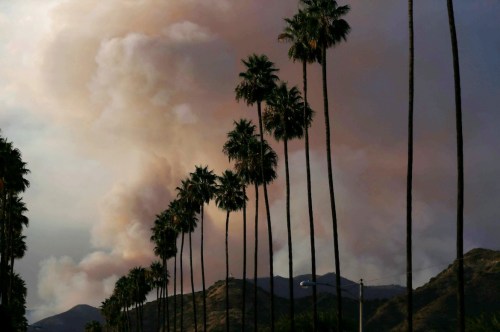As of Wednesday morning, there are more than 60 large wildfires burning throughout the United States. In parts of Oregon, California, and Colorado, air quality levels are plummeting as smoke blankets populated areas. Sujana Chandrasekhar, MD, an otolaryngology partner at ENT and Allergy Associates, explains the effects of poor air quality shouldn’t be ignored. Wildfires impact both visible and invisible air quality, and your nose is your first line of defense.
Experts in This Article
Kenneth Mendez became CEO and president of the Asthma and Allergy Foundation of America (AAFA) in early 2018. He came to AAFA from AdvaMed, the world’s largest medical technology association, where he served as senior executive vice president and chief revenue officer for 12 years.
Melanie Carver became chief mission officer for AAFA in 2020. Previously, she served as vice president of community health and marketing from 2016 through 2020. She leads the organization’s community services, marketing and communications, education, and grassroots advocacy.
otologist/neurotologist based in New York City
“The nose’s normal function is to filter impurities from the air and moisten and warm up the air so that clean, moist, warm air gets to the lungs,” says Dr. Chandrasekhar. “When the air is so impure, the functionality of the nose as the first-line filter gets greatly reduced. If you breathe in through your mouth because your nose is irritated, the filtering and warming/moistening activities do not work.”
And as you breathe that air in, it irritates the lining of your nose, mouth, throat, windpipe, and lungs. This can lead to breathing issues like coughing and wheezing.
“Anything that irritates as it passes your larynx, or voice box, to get to your lungs will cause you to cough or clear the throat, which can itself cause further irritation in that area—causing hoarseness or breathiness, including an inability to complete a sentence in one breath.”
Additionally, burning or hot particles can singe the hairs on the inside of the nose or burn your lips, nasal lining and-or oral lining. “When the nasal lining gets so dry, people are prone to nosebleeds. The more frequently you have nosebleeds, the longer it takes for recovery,” she says. Additionally, poor air quality can make your allergies and environmental sensitivities worse. “Bad air quality outside can make your dust or dog allergy inside act up.”
And these impacts can happen even if you don’t live super close to an active fire, explains Kenneth Mendez, CEO and president of the Asthma and Allergy Foundation of America. Currently, smoke has blown as far as the east coast, creating unhealthy air quality in states as far a New York and Maine.
“Wildfires do not only affect people in the immediate fire area,” he says. “Smoke can blow many miles away and impact people hundreds and even thousands of miles away. Smoke and ash contain harmful particles that can irritate even healthy lungs.”
How to protect yourself when the air quality is unhealthy
Melanie Carver, chief mission officer of the Asthma and Allergy Foundation of America says that if you live in an area prone to wildfires, or other forms of pollution, be sure to keep an eye on the Air Quality Index (AQI).
“When air pollution is high, keep your windows and doors closed,” she says. “If possible, only go outside when the air quality is better. If you do need to go outdoors, wear a mask. If air pollution is at hazardous levels, an N-95 rated mask would provide protection for your airways.”
Refrain from exercising or doing any breathing-intensive activities when outside. It’s okay to exercise indoors, just be sure to take frequent water breaks, says Dr. Chandrasekhar.
You’ll also want to stay well hydrated. When the air quality is poor your skin can get dry and lead to mouth breathing, which leads us to lose more fluids.
“When our mucous membranes (lining of nose/mouth/throat/air passages) are dry, they become inefficient,” says Dr. Chandrasekhar. “Remember how bad things taste when your mouth is really dry? It’s because your taste buds are not up to par in that condition. Hydrating up is very restorative.”
During times of poor air quality, Dr. Chandrasekhar says to use a saline mist, spray, or gel in your nose frequently.
“I’m a big fan of saline gel,” she says. “It’s easy to apply and very soothing—and lasts for a long time.” She adds that air purifiers and humidifiers can help improve your indoor air quality.
“You can get a small HEPA-filter type air purifier that will work really well in a room,” she says. “You don’t have to do a big HVAC job to get the benefit. Cool-mist humidifiers are also nice,” she says. They keep the air moist which makes small particles in the air get heavy and fall down so you don’t breathe them in.
Additionally, aim to breathe in through your nose to properly filter the air you inhale.
“There’s a type of Yogic breathing called ‘pranayama’ with controlled breaths in and out,” she says. “This is a healthy and restful way to keep sure that your air passages are getting the proper ‘exercise’ and are able to withstand some degree of atmospheric change. It is also a great way to quell anxieties which are rampant especially in bad times like these.”
A simple pranayama exercise you can try is breath extension. Start by inhaling for four to five counts through the nose. Hold for four counts. Then exhale deeply through the mouth while making a sound. Repeat. Keep in mind that all of these same tips apply to times when poor air quality in your area isn’t caused by wildfires.
Sign Up for Our Daily Newsletter
Get all the latest in wellness, trends, food, fitness, beauty, and more delivered right to your inbox.
Got it, you've been added to our email list.











